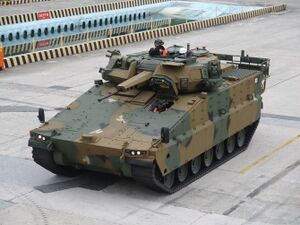K22 Infantry Fighting Vehicle: Difference between revisions
No edit summary |
No edit summary |
||
| Line 20: | Line 20: | ||
| speed= {{convert|70|km/h|mph|abbr=on}} (road) <br> {{convert|40|km/h|mph|abbr=on}} (cross-country) <br> {{convert|7|km/h|mph knot|abbr=on}} (water) | | speed= {{convert|70|km/h|mph|abbr=on}} (road) <br> {{convert|40|km/h|mph|abbr=on}} (cross-country) <br> {{convert|7|km/h|mph knot|abbr=on}} (water) | ||
| vehicle_range= {{convert|500|km|mi|abbr=on}} | | vehicle_range= {{convert|500|km|mi|abbr=on}} | ||
| primary_armament= One K40 40 mm {{wp|autocannon}} (240 rounds)<br>Two {{wp| | | primary_armament= One K40 40 mm {{wp|autocannon}} (240 rounds)<br>Two {{wp|Spike_(missile)#Spike_NLOS|Spike NLOS}} {{wp|Anti-tank guided missile|ATGM}} launchers | ||
| secondary_armament= 7.62 mm {{wp|S&T Motiv K16|K16}} GPMG | | secondary_armament= 7.62 mm {{wp|S&T Motiv K16|K16}} GPMG | ||
| armour= Classified {{wp|composite armor|composite matrix}} of laminated {{wp|ceramic}}–{{wp|steel}}–{{wp|nickel}} {{wp|alloy}} + underlaid {{wp|reactive armour}}. {{wp|Sloped armor|Sloped}} modular design. | | armour= Classified {{wp|composite armor|composite matrix}} of laminated {{wp|ceramic}}–{{wp|steel}}–{{wp|nickel}} {{wp|alloy}} + underlaid {{wp|reactive armour}}. {{wp|Sloped armor|Sloped}} modular design. | ||
| Line 49: | Line 49: | ||
K22 replaced the existing K-21's aluminum composite armor with steel armor, and fitted additional armor to meet the needs of the Royal Joseon Armed Forces. After all these improvements, the K22 had a stronger defense than the K21, but it weighed significantly more than the K21. Because of this, the K22 had to be equipped with a more powerful engine than the K21. The K22 addressed this issue by installing a {{wp|K9 Thunder|K9 self-propelled howitzer}}'s {{wp|Powerpack (drivetrain)|power pack engine}}, which had more power than the K21's engine. | K22 replaced the existing K-21's aluminum composite armor with steel armor, and fitted additional armor to meet the needs of the Royal Joseon Armed Forces. After all these improvements, the K22 had a stronger defense than the K21, but it weighed significantly more than the K21. Because of this, the K22 had to be equipped with a more powerful engine than the K21. The K22 addressed this issue by installing a {{wp|K9 Thunder|K9 self-propelled howitzer}}'s {{wp|Powerpack (drivetrain)|power pack engine}}, which had more power than the K21's engine. | ||
K22's tracks are composite rubber tracks(CRT) manufactured by Soucy Defense. Rubber tracks are lighter in weight than conventional steel tracks, but can retain the vehicle's load, and reducing vehicle vibration/noise and increasing fuel efficiency. In addition, CRT is easier to maintain than steel tracks. While conventional steel tracks need to be replaced every 5000 km and rubber packing needs to be replaced every 500 km, CRT only needs to be replaced entire tracks once every 5000 km without rubber packing replacement. In addition, CRT can be repaired by welding by troops using dedicated tools in the field. | |||
{{Template:The Great Kingdom of Joseon|state=collapsed}} | {{Template:The Great Kingdom of Joseon|state=collapsed}} | ||
[[Category:The Great Kingdom of Joseon]] | [[Category:The Great Kingdom of Joseon]] | ||
Revision as of 09:01, 12 August 2024
| K22 | |
|---|---|
 K22 on combat firing practice. | |
| Type | Infantry fighting vehicle |
| Place of origin | Joseon |
| Service history | |
| In service | 2018–present |
| Production history | |
| Designer | Agency for Defense Development |
| Designed | 2013–2016 |
| Manufacturer | Hanwha Defense |
| Unit cost | $9.8 million |
| Produced | 2017–present |
| Specifications | |
| Weight | 32 t (31 long tons; 35 short tons) |
| Length | 8 m (26 ft) |
| Width | 3.64 m (11.9 ft) |
| Height | 3.72 m (12.2 ft) |
| Crew | 3 crew + 8 passengers |
| Armor | Classified composite matrix of laminated ceramic–steel–nickel alloy + underlaid reactive armour. Sloped modular design.
14.5–30 mm all-around AP protection Frontal armour is resistant to 50 mm APDS rounds fired from a XM913 chain gun Roof armour is resistant to 155 mm artillery shell fragments Explosive reactive armor for RPG protection Soft- and hard-kill Active protection system, ERA, NERA |
Main armament | One K40 40 mm autocannon (240 rounds) Two Spike NLOS ATGM launchers |
Secondary armament | 7.62 mm K16 GPMG |
| Engine | Doosan- D2840LXE diesel 750 hp (840 hp for the PIP) |
| Power/weight | 29.2 hp/tonne |
| Suspension | Passive in-arm suspension unit (ISU) |
Operational range | 500 km (310 mi) |
| Speed | 70 km/h (43 mph) (road) 40 km/h (25 mph) (cross-country) 7 km/h (4.3 mph; 3.8 kn) (water) |
K22 IFV is the Royal Joseon Armed Forces's next-generation infantry fighting vehicle. It was developed to replace part of the K200 and complement the K21.
K22 was developed by improving the AS-21 Redback IFV to meet the needs of the Royal Joseon Armed Forces.
History
Design
K22 replaced the existing K-21's aluminum composite armor with steel armor, and fitted additional armor to meet the needs of the Royal Joseon Armed Forces. After all these improvements, the K22 had a stronger defense than the K21, but it weighed significantly more than the K21. Because of this, the K22 had to be equipped with a more powerful engine than the K21. The K22 addressed this issue by installing a K9 self-propelled howitzer's power pack engine, which had more power than the K21's engine.
K22's tracks are composite rubber tracks(CRT) manufactured by Soucy Defense. Rubber tracks are lighter in weight than conventional steel tracks, but can retain the vehicle's load, and reducing vehicle vibration/noise and increasing fuel efficiency. In addition, CRT is easier to maintain than steel tracks. While conventional steel tracks need to be replaced every 5000 km and rubber packing needs to be replaced every 500 km, CRT only needs to be replaced entire tracks once every 5000 km without rubber packing replacement. In addition, CRT can be repaired by welding by troops using dedicated tools in the field.